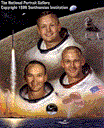

Apollo 11 and the Lunar Landing
 Apollo
11 Crew
Apollo
11 Crew
Ronald B. Anderson (born 1929)
Oil on prepared board, 1969, T/NPG.70.36
National Portrait Gallery,
Smithsonian Institution, Washington, D.C.
Gift of Mr. and Mrs. William D. Blakemore, Midland, Texas; Mr. and Mrs.
Omar Harvey, Dallas, Texas; Mr. and Mrs. R. K. Keitz, Dallas, Texas; Col.
and Mrs. Thomas A. P. Krock, Dallas, Texas; Mr. and Mrs.W. R. Lloyd, Jr.,
Houston, Texas; Dr. and Mrs. J. R. Maxfield, Dallas, Texas; Mr. and Mrs.
Wesley Nagorny, Jr., Houston, Texas; Dr. and Mrs. H. B. Renfrow, Dallas,
Texas; Mr. and Mrs. J. W. Taylor, Dallas, Texas; Dr. and Mrs. J. Robert
Terry, Miami, Florida; Mr. and Mrs. Thomas B. Young, Dallas, Texas; anonymous
donor
With "one small step for man, and one giant leap for mankind," at 10:56 p.m. EDT on July 20, 1969, astronaut Neil Alden Armstrong became the first person to walk on the moon's surface. The successful Apollo 11 mission fulfilled the challenge that President John F. Kennedy had issued to Congress on May 25, 1961--to send a man safely to the moon and back by 1970. In addition to mission commander Armstrong, the crew included Edwin "Buzz" Aldrin, Jr., and Michael Collins, who were both Air Force officers.
The Apollo 11 mission was launched on July 16, 1969, from NASA's Kennedy Space Center in Florida. The spacecraft reached the moon's orbit, 244,930 miles from earth, by July 19. While the command module Columbia orbited the moon, mission control in Houston determined when the descent maneuvers could begin. First, Armstrong and Aldrin boarded the lunar landing module Eagle while Collins remained aboard Columbia, monitoring systems. Eagle then undocked from Columbia, at 1:47 p.m. on July 20. At 4:18 p.m. Armstrong announced the landing module's touchdown on the moon to Houston mission control with the now-famous message "the Eagle has landed." Up to this point, millions of television viewers had only been able to hear the radio communication between the astronauts and mission control. Eagle however, had a television camera attached to its outside steps. When Armstrong emerged to take his famous stroll on the moon's surface, the world was able to watch. A few minutes later, Aldrin joined him. The two astronauts spent more than two hours collecting scientific data and exploring the moon's surface.
After about twenty-four hours on the lunar surface, Eagle lifted off, to redock with Columbia. After Armstrong and Aldrin climbed back into the command module with Collins, Eagle was jettisoned into space. The astronauts made their return trip to Earth in approximately sixty hours. At 12:40 p.m. on July 24, Apollo 11 splashed down in the Pacific Ocean, just southwest of Hawaii.
LINKS